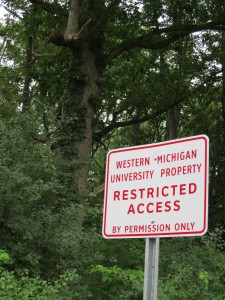For 33 years, from 1977 to early 2010, the Colony Farm Orchard was protected by a restrictive covenant. By virtue of the terms of the gift to Western Michigan University by the state of Michigan, this land was to be kept as open space for public use.
Now, as can be seen, WMU is telling us the land is restricted again in a different way.
On 17 July 2010, David Nesius, a conservationist interested in retaining the Colony Farm Orchard as a natural area, noticed activity at the Orchard. Workmen were installing new signs that read Western Michigan University Property RESTRICTED ACCESS By Permission Only.
He spread the word via email about this new restriction on the public’s access to the land.
I was struck by the date on which the restricted access signs were posted. On 16 July 2009, exactly one year ago, Representative Robert Jones introduced House Bill 5207. This was the bill designed to strip the protective covenant from the Orchard land. The timing of the legislation, some of us suspected, was designed to hide the attack on the Orchard as long as possible, occurring as it did when most students were away, many faculty were in libraries or at field sites scattered around the world, and many townspeople were on vacation.
Was the timing of the new signs a re-run of a successful gambit? Maybe. I didn’t learn they’d gone up until I got back from a visit out East, so it kept me in the dark for a week.
On the other hand, the legislators who collaborated in dismantling the conservation covenant on the Orchard might wish that the signs had been delayed until after the August primaries or even the general elections in November. Such a threatening display from WMU may bring back bad memories for some voters.
The Wednesday 21 July Kalamazoo Gazette carried an article by Paula Davis about the new signs. She quoted WMU Associate Vice President for Community Outreach, Bob Miller, as saying that a concern for public safety prompted their installation. “We just want to know who is going to be there and what their plans are. We’re not saying, ‘No Trespassing.’ We’re not saying, ‘Keep out’.”
When asked by reporter Davis how to get permission to be on the property, Miller said that people could “call the university and the university will direct them to the correct office.” The Gazette article concluded with the university switchboard number.
Ladislav R. Hanka, local artist and conservationist, pursued the matter, finally talking with Donna Marks, executive assistant in the office of the Vice President for Advancement and Legislative Affairs. After some discussion, it appeared that an email to Ms Marks (Donna.Marks@wmich.edu) containing one’s name, interest in the Orchard, what he or she would be doing there, when or how often visits might be, and who one’s companions might be would suffice. Probably Ms Marks could provide further information if desired (387-2072).
Obtaining permission to visit the Orchard is highly desirable. Whatever the signs were meant to accomplish, they should not prevent anyone from continuing (or beginning) their bird watching, asparagus picking, snow shoeing, bur oak hugging, plein air painting, or any other other kind of nature, conservation, or environmental activity.
It’s well to remember that the Orchard land is still available for permanent protection. Even though the open space/public use covenant has been removed, WMU is not compelled to expand the BTR park onto this land. It’s a fact that the original language of HB 5207 called for a new restriction that WMU would use the land for BTR Park expansion. But after that language served its purpose as a more-or-less plausible justification for dumping the conservation covenant, the language was dropped, even before the bill left Representative Jones’s House Commerce Committee.
The upshot is that the WMU administration and board have the power to grant continued life to the Orchard, and they will bear the responsibility for any death sentence.
In the meantime, the Orchard land lives and participates in the ecological functioning of Asylum Lake Preserve.
